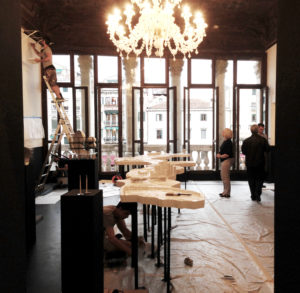By Jackson Fox

University of Houston students presented at the 2014 Architectural Biennale in Venice, Italy. Assembling the Risky Habit[at] exhibition took four days of unpacking and building. Photo courtesy of Jackson Fox.

The Three Continents Studio Exhibition on display in the Gerald D. Hines College of
Architecture at the University of Houston. Photo courtesy of Peter Zweig.
In the wake of recent water-related disasters around the globe, the Gerald D. Hines College of Architecture at the University of Houston is spearheading an international research effort to explore and elevate these critical questions on a global stage. This consortium, entitled “Three Continents Studio: Living in Dynamic Equilibrium,” is led by Houston architect and educator, Peter Zweig. Together, the students and faculty of Tulane University in New Orleans, the University of Buenos Aires in Argentina, the Delft University of Technology in the Netherlands, and architecture students at the University of Houston embarked on an unprecedented exploration to analyze the urban condition in each of their respective coastal cities. Professor Zweig emphasized the importance of “building a concept around [water and flooding]” to channel the efforts of each school into one, cohesive story. Though each city brings unique and local challenges to the forefront, they all share a long-established history of systematic flooding issues. As these four schools on three continents combine research, exchange ideas, and conceptualize solutions, they demonstrate innovative approaches to city planning and showcase cooperative values, symbolic and indispensable to architecture in the twenty-first century.
To read the pdf of the full article click here.–
Watch the film of the Three Continents Project
[youtube]https://youtu.be/2pFMWCE_R3M[/youtube]

Three Continents students John Smead and David Regone work on assembling the final
presentation model of Buffalo Bayou that will stretch over twenty feet long and weigh nearly three hundred pounds. Photo courtesy of Jackson Fox.

Together, arhitecture students from New Orleans, Argentina, the Netherlands, and Houston
glide through downtown Houston on Buffalo Bayou. Photo courtesy of Jackson Fox.


 Follow
Follow